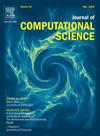AFF-BPL:使用基于 Bat-PSO-LSTM 框架的自适应特征融合技术诊断自闭症谱系障碍
IF 3.7
3区 计算机科学
Q2 COMPUTER SCIENCE, INTERDISCIPLINARY APPLICATIONS
引用次数: 0
摘要
自闭症谱系障碍(ASD)是一种神经系统疾病,表现为身体健康、社会交往、多动行为和敏感性增强等方面的缺陷。自闭症的延迟诊断是减轻其严重影响的一大障碍。ASD 患者通常表现出局限性和重复性的行为模式。在此背景下,我们提出了一种基于 BAT-PSO-LSTM 网络的新型自适应特征融合技术,用于自闭症谱系障碍的诊断。我们将重点放在三个不同的自闭症筛查数据集上,即幼儿、儿童和成人数据集,以便对技术进行全面分析。Bat 和 PSO 同时选择特征,所选特征将经过自适应特征融合算法和基于 LSTM 的分类器。这项研究解决了现有技术中遇到的各种挑战,包括与过拟合、更快的训练、可解释性、泛化能力和减少计算时间有关的问题。该研究结合了神经网络、CNN 和 LSTM 等基线技术,并根据精度、特异性、准确度、灵敏度和 f1 分数等关键参数进行了评估。实验模拟显示,AFF-BPL 在所有三个数据集上的准确性都优于所考虑的基准技术。具体来说,该模型在幼儿、儿童和成人数据集上的准确率分别达到了 0.992、0.989 和 0.986。此外,对功能和结构图像的探索将有助于深入了解 ASD 的内在机制。本文章由计算机程序翻译,如有差异,请以英文原文为准。
AFF-BPL: An adaptive feature fusion technique for the diagnosis of autism spectrum disorder using Bat-PSO-LSTM based framework
Autism spectrum disorder (ASD) is a neurological condition revealed by deficiencies in physical well-being, social communication, hyperactive behavior, and increased sensitivity. The delayed diagnosis of ASD showcases a significant obstacle in mitigating the severity of its impact. Individuals with ASD often exhibit restricted and repetitive behavioral patterns. In this context, we proposed a novel adaptive feature fusion technique with a BAT-PSO-LSTM-based network for the diagnosis of autism spectrum disorder. Our focus is on three distinct autism screening datasets namely, Toddlers, Children, and Adults for comprehensive analysis of techniques. Bat and PSO concurrently select features and the selected features will go through an adaptive feature fusion algorithm and an LSTM-based classifier. This research addresses various challenges encountered in the existing techniques including concerns related to overfitting, faster training, interpretability, generalization capability, and reduced computation time. The work incorporates baseline techniques like a neural network, CNN, and LSTM with evaluations based on key parameters like precision, specificity, accuracy, sensitivity, and f1-score. The experimental simulations reveal that AFF-BPL outperforms considered baseline techniques achieving remarkable accuracy on all three datasets. Specifically, the model attains the accuracy of 0.992, 0.989, and 0.986 on toddler, children, and adult datasets respectively. Additionally, the exploration of functional and structural images will provide deeper insights into the underlying mechanism of ASD.
求助全文
通过发布文献求助,成功后即可免费获取论文全文。
去求助
来源期刊

Journal of Computational Science
COMPUTER SCIENCE, INTERDISCIPLINARY APPLICATIONS-COMPUTER SCIENCE, THEORY & METHODS
CiteScore
5.50
自引率
3.00%
发文量
227
审稿时长
41 days
期刊介绍:
Computational Science is a rapidly growing multi- and interdisciplinary field that uses advanced computing and data analysis to understand and solve complex problems. It has reached a level of predictive capability that now firmly complements the traditional pillars of experimentation and theory.
The recent advances in experimental techniques such as detectors, on-line sensor networks and high-resolution imaging techniques, have opened up new windows into physical and biological processes at many levels of detail. The resulting data explosion allows for detailed data driven modeling and simulation.
This new discipline in science combines computational thinking, modern computational methods, devices and collateral technologies to address problems far beyond the scope of traditional numerical methods.
Computational science typically unifies three distinct elements:
• Modeling, Algorithms and Simulations (e.g. numerical and non-numerical, discrete and continuous);
• Software developed to solve science (e.g., biological, physical, and social), engineering, medicine, and humanities problems;
• Computer and information science that develops and optimizes the advanced system hardware, software, networking, and data management components (e.g. problem solving environments).
 求助内容:
求助内容: 应助结果提醒方式:
应助结果提醒方式:


